Peru - treats of Lima, spiritual Amazon jungle visit and the navel of the Inka empire
Ecuador didn‘t make it easy for us to leave, while already at the gate Diana was called out and then taken into a police room to search her bags for drugs. Apparently interesting to observe the procedure, the officer let her go just in time before gate closure. And even her bag made it to the plane and eventually Lima. The capital of Peru, widespread and massive at the coast, with 12-14 million people is one of the biggest cities and considered the food capital of South America. We stayed in Miraflores, the yuppie neighborhood where it felt like being somewhere in the US: wide streets, lanes for micro mobility, palm trees and parks with people exercising next to the beach where plenty of surfers enjoyed the waves, clean and modern streets and buildings, nice restaurants and a functioning public transportation system. We enjoyed a yoga class, barbershop & nail salon, some local cuisine (although once again vegetarian options - required for out pre-ayahuasca diet - where hard to find), a run under palm trees and a visit to the movies. Of course Lima being such a massive city, there are neighborhoods that are extremely poor and a visit is dangerous and not recommended.
During a guided city tour we learned more about the cuisine and how the Peruvian national sport is eating (only second after football), hence vegetarian options were not so popular. The cuisine as the culture are a blend of Peruvian, Asian, African, indigenous and Spanish based on the history of Peru; especially popular are chifa restaurants a fusion of Chinese and Peruvian food. The range of restaurants goes from cheap but yummy street food or small stalls to high class options, even Michelin star restaurants. Popular dishes include ceviche, chaufa, causa and of course guinea pig.. Most important local ingredients are potatoes (Peruvians are proud to grow over 3,000 different types), quinoa of all sorts, avocados, grapes and a wide range of fruits.
Recommended by friends, we took a (loong) day trip along the coast where we first encountered an abundance of bird life and sea lions around Paracas resp. Islas Balletas, we learned that once a year the guayna on the islands is being „harvested“ to be sold and exported as fertilizer. A pisco tasting was obviously part of a day trip in Peru, and here we forgot about the strict diet for a brief hour ;) How could we have missed out on the drink that Peru is most proud of and has intense fights over with Chile about the origin of pisco - no doubt from our side, it‘s 100% Peruvian. The day was well rounded off with a sand buggy tour through the desert to see the oasis of Huacachina as well as finally giving sandboarding a try.
After Lima the Amazon of Peru was waiting for us; a short flight took us to Iquitos, one of the biggest cities in the world (700,000 people) that doesn‘t have access by road - you can only get there by plane or boat. Two hours down the Amazon river curiosity had taken us into an ayahuasca retreat in the middle of the jungle: 7 days, 12 people, 2 shamans + 1 interpreter, the crew of the refugio, and the ancient jungle medicine of ayahuasca..
Ayahuasca is a liane that grows in the Amazon region and is being boiled with Chakruna leaves (containing the substance called DMT) until a thick, muddy soup forms which takes two days to process before its filtered and ready for drinking - an earthy, fermented taste. The medicine is known to have the power to heal mental illnesses, rid body and mind of negative energy (through vomiting and diarrhea) and offer spiritual journeys and revelations (aka visions).
After the introduction of the shamans, the preparation process and settling into our huts, there was a loot of waiting and anticipation involved; this should reoccur between each and every ceremony as the shamans wanted us to relax, reflect, meditate and keep positive, most importantly trust the process. There was quick recap with the shamans after every ceremony as well to check if the dosage was right and briefly discuss our experience.
The ceremonies take place at night in a large hut where all 12 people had a mattress each, placed in a circle and the shamans on one side. While the medicine starts working it‘s complete darkness, only the sounds of the jungle around before the shamans start their chants (icarus) and are able to steer the experience and visions. Additionally, they smoke and blow flavoured puffs into the room. The ceremony ends with one of the shamans chanting right in front of every individual person, still this kind of private session gives me the chills, it felt quite magical to be this intimately connected.
The first ceremony was super intense for me, I fell in a deep trance like state with many dark images and visions, I’ve connected to deep rooted trauma and felt a lot of pain. All around me everyone had a different experience, what most had in common though was throwing up and diarrhea - creates quite an atmosphere with the sounds of everyone. By the end of the ceremony Diana had to stabilize me on the way home, the next morning I was already done with the retreat and ready to leave.
I could find some trust in the work of the shamans though, indeed this was the most important point, and the second ceremony was actually quite a pleasant one that I enjoyed and was able to cure some of the pain from the night before. The third ceremony I got too much into my own head and resistance, the effect of the medicine was very light and I stayed in control. For the fourth and last ceremony (for about half the group, the rest stayed another 5 days longer) most people received a higher dose and it turned to complete madness. Never in my life have I felt so much excruciating physical and emotional pain, I only had dark images and even the shamans chanting didn‘t bring any relieve. They wanted to make sure that all and every bit of negative energy came out, especially for the people leaving the next day. I was tripping until 7am, barely slept and only recovered after a cold shower in the pouring rain..
I was so done with this entire retreat, the jungle and mosquitoes, damp clothes and the pain I‘ve went through. After a last recap, we were finally put on a boat back to Iquitos where I eventually started to relax and see the (positive) effects of the retreat, had a lightness and gratefulness for my life rising up. However, it took me an entire 2 weeks to fully process, I had dreams haunting me and certain smells and sounds reminded me of the experience and threw me back. By now I have reflected a lot more, put things into perspective and also value the experience and the significant positive changes in others I‘ve witnessed (i.e. from very desperate, even suicidal to energetic and light). I don‘t think ayahuasca is for everyone, you need a strong reason or purpose to go through at times very unpleasant and uncomfortable feelings, yet it can be very rewarding and beneficial. Seeing and experiencing the shamans work was absolutely and truly magical, I won‘t do this ever again though.
One day resting in Iquitos, rewarding and treating ourselves with food that wasn‘t allowed or available during the retreat, and then we made our way to Cusco, what a change in altitude (100m to 3,400m) and temperature (30°C+ to 10°C) yet again. Learning from my earlier experience with high altitude we were smarter and took some days to acclimatize and take it easy before the Machu Picchu trek. So we explored the very beautiful (colonial) town of Cusco, did some planning and booking for the rest of our trip, took a Peruvian cooking class to learn how to prepare ceviche and pisco sour, got overwhelmed by colours and products when souvenir shopping, and visited the sacred valley around Cusco with few Inka sites, salt mines and chocolate factories.
After five days of acclimatization (only slight headaches and irritation of digestive system this time) we felt ready for the multi-day trek to Machu Picchu. As high season had begun the most famous 4d Inca trail was booked out for the rest of May, we opted for the 5d Salkantay trek which is slightly longer and reaches the sacred site of Machu Picchu from a different side. Supposedly, the Salkantay trek has the better views and change of scenery, unfortunately we were not super lucky with the weather and clouds as well as rain prohibited enjoying the natural views and places as much; climate change and el niño brought us a late glimpse of rainy season in Peru.
Nevertheless, the first day we climbed a steep slope to Humantay lagoon and found our first campsite (no ordinary tents of course!) on 4,000m among snowcapped mountains and clouds. We met yet another travel family, a group of 16 people (8 young Brits, 2 Aussies, 1 Canadian, 1 Norwegian, 1 Indian, 1 French & us) that gave us a lot of entertainment and drama. On day 2 we passed the highest point of the trek (4,650m), struggling with shortage of breath, but extremely happy when reaching the second camp on much lower altitude already. Some of our friends immediately got the cocaine out, not to forget alcohol and weed, which made for a toxic dynamic and night to remember forever, especially since our tour guide got wasted, too: words were exchanged, feelings hurt, people starting to shout at each other, it was fun and painful at the same time to watch. One member of the group wouldn‘t let go the entire trek and found herself completely isolated, though there would be two more nights with some drama and shouting.
Hurting calves, soaked shoes, 70km down in four days we finally got to the place of our dreams: Machu Picchu, the unreal Inka site covered in the mountains the Spaniards never found luckily. The astronomical centre of the Inkas boasts with symbols of connection with nature (sun, moon, condor, jaguar and snake for past, present and future) and makes for a magical & eerie place not only from the iconic view point. The sky was clear but the rain kept coming throughout, so we got some great photos but cut our walk through the actual site short because everyone was freezing and soaked.
After a relaxing half-day in Aguas Calientes and a farewell lunch with the other hikers we got on a PeruRail train back to Cusco, where we were planning to order in pizza and make use of the bathtub in our hotel. Lucky us, a rock fell on the tracks and we got stuck inside the train for several hours. Diana being Diana, she tried solving the situation and working out a solution with both the manager of the train as well as the manager from our tour operator. Eventually, the train continued and we didn‘t have to put on our wet shoes again to walk on the railway tracks in the dark and cold. But our plans in Cusco literally fell apart, not only due to our late arrival but also to issues with the sewage system in all Cusco. Instead we tried to blowdry our wet clothes and shoes in the hotel, went to bed early and jumped on a bus to Puno the very next morning.
Our last stop in 3.5 weeks in Peru was the immense Lake Titicaca, the highest lake in the world on 3,800m. We arrived in Puno after an 8h very comfortable bus ride with a view (double-decker front row seats ftw), booked ourselves an overnight island homestay for the next day and finally had the pizza we had craved for.
By small boat we cruised around the peaceful lake to visit the communities living on the floating islands far back in time and in their own small bubble, and the islands of Amantani and Taquile, both with their own communities and customs. On Amantani island we climbed to 4,100m to see some small temples for Patchamama and Patchatata and stayed with a local family that cooked for us and took us to a dance event in the evening. The best part of this was the walk back in total darkness and being able to stargaze and see the milky way. In Isla Taquile we had a short walk, played with some local kids and then returned to Puno after a yummy lunch.
















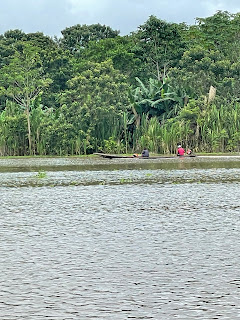









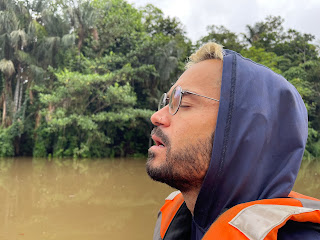








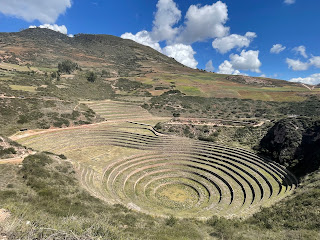



















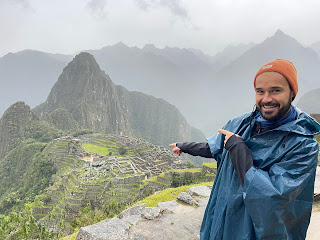








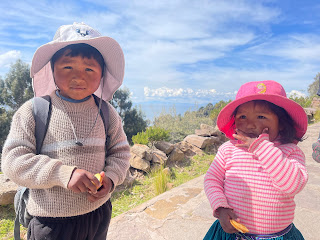

Comments